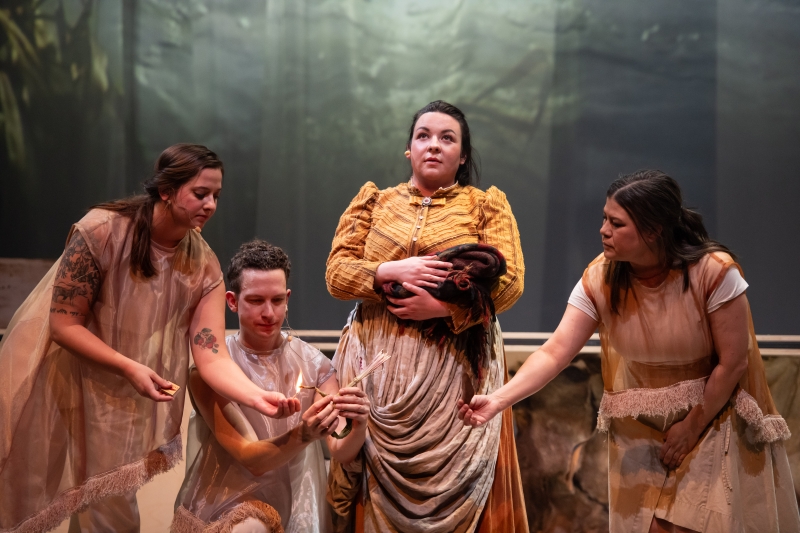Review: YOU USED TO CALL ME MARIE... at the National Arts Centre
Everything you could want a play to be: thought-provoking, heart-wrenching, and inspirational.
Tai Amy Grauman’s You used to call me Marie… is a celebration of the Métis people’s strength and resilience through centuries of adversity. The play features a combination of traditional storytelling, history, and romance. Before bringing You used to call me Marie… to the professional stage, Grauman toured the production throughout the Métis homelands in Alberta, Saskatchewan, and Manitoba to ensure it resonated with the community and reflected their experiences.

The play follows several couples, all played by Grauman (Iskwewo, the Cree word for woman) and Aren Okemaysim (Napew, the Cree word for man) from the 1700s to the present day, following multiple generations of “Maries” and their spouses through the harsh challenges faced by the Métis Nation.
At the beginning of the show, we see wild horses galloping freely, the buffalo plentiful on the plains. The river steadily flows, the flourishing gardens being tended to by the loving hands of the Cree women, the sweetgrass growing tall and bountiful. Then, the Sun Traveler, a fur trader, visits and gives the first Marie that we meet a tobacco plant, a symbol of the colonizers. She plants it in her garden and, even though conditions are not right, the tobacco grows against all odds.
Despite their differences, the Sun Traveler and Marie fall in love. The Métis are the sons and daughters of the unions between the Cree people and Europeans. This is represented by the eventual intertwining of the sweetgrass and the tobacco plants within Marie’s garden. Many Métis also practice Catholicism; their language, Michif, is a fusion of Cree and French. Equally unwelcome on the lands inhabited by first nations and Europeans, the Métis essentially squat on crown lands and fight for basic human needs. Sporadic moments of hope, such as the provision of land scrips, prove to be fruitless and it seems as though the Métis may not survive. The struggle is mirrored in the disappearance of the buffalo, and the fields that become increasingly barren; the sweetgrass and tobacco fight for survival.
Ultimately the Métis men, led by Louis Riel, fight the government for their land and rights. They women stay at home, praying and supporting their community. Later, children are sent to residential schools; the students eager to learn to read and write. Instead, they disappear. Throughout the passage of time, the river continues to flow, signifying that, no matter how impossible their hardships seem, the Métis will survive. At the end of the play, the sweetgrass and tobacco grow tall once again, and the wild roses and buffalo start to return to the plains... perhaps a nod to the small steps made towards reconciliation.

Performances were excellent, from the leads, Grauman and Okemaysim to the supporting performers (Cole Avis, Kathleen Nisbet, Krystle Pederson and Rebecca Sadowski), who took on various roles throughout the play. Music (composed by Andrea Menard) and dance in a wide variety of styles were incorporated into the story; the singers, captained by Pederson, were all highly capable.
The minimalist, but utilitarian set included many small props to punctuate the story (sets designed by Cecilia Vadala and props designed by Stephanie Elgersma). The design of the horses, as well as their choreography was truly impressive. Projections, designed by Candelario Andrade, provided context for the ever-changing seasons.
Although from time to time, the show felt like it was slower than necessary, You used to call me Marie… is everything you could want a play to be: thought-provoking, heart-wrenching, and inspirational. It has motivated me to dust off my history books and update my knowledge and understanding of the Métis Nation.
You used to call me Marie… is co-produced by the National Arts Centre and Savage Society. It runs through June 16th at the National Arts Centre's Babs Asper Theatre. Click here for more information or click the link below to purchase tickets.
Reader Reviews
Videos

